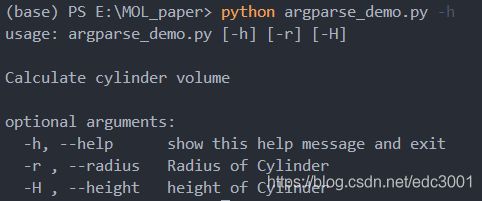【python 学习杂记】argparse模块使用教程
argparse模块使用教程
- 1、argparse介绍
- 2、未使用argparse示例
- 3、使用argparse示例
-
- 2.1 argparse简单示例
- 2.2 argparse进阶示例
-
- 2.2.1 可选参数设置
- 2.2.2 可选参数引用名
- 2.2.3 清除帮助中的参数名信息
- 2.2.4 必选参数设置
- 2.2.5 列表参数(多参数)传入设置
- 2.2.6 互斥参数使用
- 2.2.7 默认参数设置
1、argparse介绍
argparse是一个用来解析命令行参数的 Python 库,它是 Python 标准库的一部分。基于 python 2.7 的 stdlib 代码。
argparse模块使编写用户友好的命令行界面变得容易。程序定义了所需的参数,而argparse将找出如何从sys.argv(命令行)中解析这些参数。argparse模块还会自动生成帮助和使用消息,并在用户为程序提供无效参数时发出错误。
2、未使用argparse示例
一般未使用到终端命令,对于一些需要变量赋值的程序,我们往往:
- 1、直接在程序中(或配置文件)写死。
- 2、或者利用input在命令行多次输入
这样不易多次调试及修改运行,如下就是一个示例:
import math
def cal_vol(radius,height):
vol = math.pi * pow(radius,2) * height
return vol
if __name__=='__main__':
print(cal_vol(2,4))
3、使用argparse示例
2.1 argparse简单示例
argparse使用主要有四个步骤:
- 导入
argparse包- 创建
ArgumentParser()参数对象- 调用
add_argument()方法往参数对象中添加参数- 使用
parse_args()解析添加参数的参数对象,获得解析对象- 程序其他部分,当需要使用命令行参数时,使用
解析对象.参数获取
如下是一个简单的示例:
import math
import argparse # 1、导入argpase包
def parse_args():
parse = argparse.ArgumentParser(description='Calculate cylinder volume') # 2、创建参数对象
parse.add_argument('radius', type=int, help='Radius of Cylinder') # 3、往参数对象添加参数
parse.add_argument('height', type=int, help='height of Cylinder')
args = parse.parse_args() # 4、解析参数对象获得解析对象
return args
def cal_vol(radius, height):
vol = math.pi * pow(radius, 2) * height
return vol
if __name__ == '__main__':
args = parse_args()
print(cal_vol(args.radius, args.height)) # 5、使用解析对象.参数获取使用命令行参数
2.2 argparse进阶示例
- name or flags - 选项字符串的名字或者列表,例如 foo 或者 -f, --foo。
- action - 命令行遇到参数时的动作,默认值是 store。
- – store_const,表示赋值为const;
- – append,将遇到的值存储成列表,也就是如果参数重复则会保存多个值;
- – append_const,将参数规范中定义的一个值保存到一个列表;
- – count,存储遇到的次数;此外,也可以继承 argparse.Action 自定义参数解析;
- nargs - 应该读取的命令行参数个数,可以是
- 具体的数字,或者是?号,当不指定值时对于 Positional argument 使用 default,对于 Optional argument 使用 const
- 或者是 * 号,表示 0 或多个参数;
- 或者是 + 号表示 1 或多个参数。
- const - action 和 nargs 所需要的常量值。
- default - 不指定参数时的默认值。
- type - 命令行参数应该被转换成的类型。
- choices - 参数可允许的值的一个容器。
- required - 可选参数是否可以省略 (仅针对可选参数)。
- help - 参数的帮助信息,当指定为 argparse.SUPPRESS 时表示不显示该参数的帮助信息.
- metavar - 在 usage 说明中的参数名称,对于必选参数默认就是参数名称,对于可选参数默认是全大写的参数名称.
- dest - 解析后的参数名称,默认情况下,对于可选参数选取最长的名称,中划线转换为下划线.
2.2.1 可选参数设置
import math
import argparse # 1、导入argpase包
def parse_args():
parse = argparse.ArgumentParser(description='Calculate cylinder volume') # 2、创建参数对象
parse.add_argument('--radius', default=2, type=int, help='Radius of Cylinder') # 3、往参数对象添加参数
parse.add_argument('--height', default=4, type=int, help='height of Cylinder')
args = parse.parse_args() # 4、解析参数对象获得解析对象
return args
def cal_vol(radius, height):
vol = math.pi * pow(radius, 2) * height
return vol
if __name__ == '__main__':
args = parse_args()
print(cal_vol(args.radius, args.height)) # 5、使用解析对象.参数获取使用命令行参数
通过在参数名前加
--,设置为可选参数,如果未输入,则使用default默认值(若未设置default,则会默认赋值None),如下示例:
2.2.2 可选参数引用名
import math
import argparse # 1、导入argpase包
def parse_args():
parse = argparse.ArgumentParser(description='Calculate cylinder volume') # 2、创建参数对象
parse.add_argument('-r', '--radius', default=2, type=int, help='Radius of Cylinder') # 3、往参数对象添加参数
parse.add_argument('-H', '--height', default=4, type=int, help='height of Cylinder')
args = parse.parse_args() # 4、解析参数对象获得解析对象
return args
def cal_vol(radius, height):
vol = math.pi * pow(radius, 2) * height
return vol
if __name__ == '__main__':
args = parse_args()
print(cal_vol(args.radius, args.height)) # 5、使用解析对象.参数获取使用命令行参数
2.2.3 清除帮助中的参数名信息
import math
import argparse # 1、导入argpase包
def parse_args():
parse = argparse.ArgumentParser(description='Calculate cylinder volume') # 2、创建参数对象
parse.add_argument('-r', '--radius', default=2, type=int, metavar='', help='Radius of Cylinder') # 3、往参数对象添加参数
parse.add_argument('-H', '--height', default=4, type=int, metavar='', help='height of Cylinder')
args = parse.parse_args() # 4、解析参数对象获得解析对象
return args
def cal_vol(radius, height):
vol = math.pi * pow(radius, 2) * height
return vol
if __name__ == '__main__':
args = parse_args()
print(cal_vol(args.radius, args.height)) # 5、使用解析对象.参数获取使用命令行参数
metavar在通过-h显示 usage 说明中的参数名称,对于必选参数默认就是参数名称,对于可选参数默认是全大写的参数名称.。这里通过设置为空一律不显示。
2.2.4 必选参数设置
import math
import argparse # 1、导入argpase包
def parse_args():
parse = argparse.ArgumentParser(description='Calculate cylinder volume') # 2、创建参数对象
parse.add_argument('-r', '--radius', default=2, type=int, metavar='', required=True, help='Radius of Cylinder') # 3、往参数对象添加参数
parse.add_argument('-H', '--height', default=4, type=int, metavar='', required=True, help='height of Cylinder')
args = parse.parse_args() # 4、解析参数对象获得解析对象
return args
def cal_vol(radius, height):
vol = math.pi * pow(radius, 2) * height
return vol
if __name__ == '__main__':
args = parse_args()
print(cal_vol(args.radius, args.height)) # 5、使用解析对象.参数获取使用命令行参数
2.2.5 列表参数(多参数)传入设置
import math
import argparse
def parse_args():
parse = argparse.ArgumentParser(description='Calculate cylinder volume')
parse.add_argument('-n', '--num', type=int, nargs='+', metavar='', required=True, help='a string of nums')
args = parse.parse_args()
return args
if __name__ == '__main__':
args = parse_args()
print(args.num)
for i in list(args.num):
print(i)
2.2.6 互斥参数使用
import math
import argparse
def parse_args():
parse = argparse.ArgumentParser(description='Calculate cylinder volume')
parse.add_argument('-r', '--radius', default=2, type=int, metavar='', required=True, help='Radius of Cylinder')
parse.add_argument('-H', '--height', default=4, type=int, metavar='', required=True, help='height of Cylinder')
group = parse.add_mutually_exclusive_group() # 1、在参数对象中添加互斥组
group.add_argument('-b', '--brief', action='store_true', help='print brief message') # 2、在互斥组中添加参数(store_true默认当命令行未输入参数则为False,否则为True)
group.add_argument('-v', '--verbose', action='store_true', help='print verbose message')
args = parse.parse_args()
return args
def cal_vol(radius, height):
vol = math.pi * pow(radius, 2) * height
return vol
if __name__ == '__main__':
args = parse_args()
volume = cal_vol(args.radius, args.height)
if args.brief:
print(volume)
elif args.verbose:
print('Volume of Cylinder with radius %s and height %s is %s' % (args.radius,args.height,volume))
else:
print('Volume of Cylinder is %s' % (volume))
2.2.7 默认参数设置
set_defaults()可以设置一些参数的默认值
import math
import argparse
def parse_args():
parse = argparse.ArgumentParser(description='Calculate cylinder volume')
parse.add_argument('-r', '--radius', default=2, type=int, metavar='', required=True, help='Radius of Cylinder')
parse.set_defaults(height=4)
args = parse.parse_args()
return args
def cal_vol(radius, height):
vol = math.pi * pow(radius, 2) * height
return vol
if __name__ == '__main__':
args = parse_args()
print(cal_vol(args.radius, args.height))
参考:
- Python argparse命令行参数解析包的详细使用说明书





